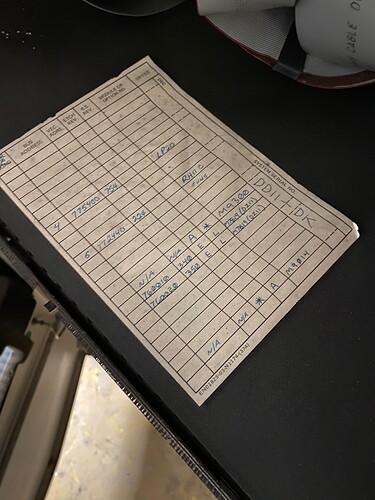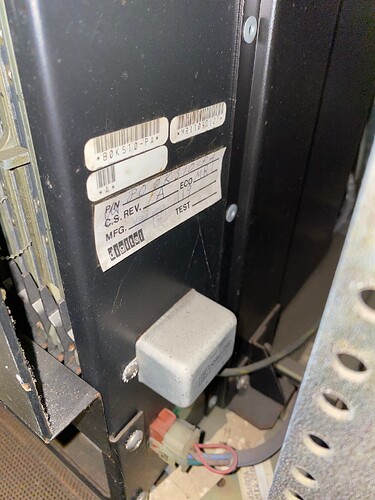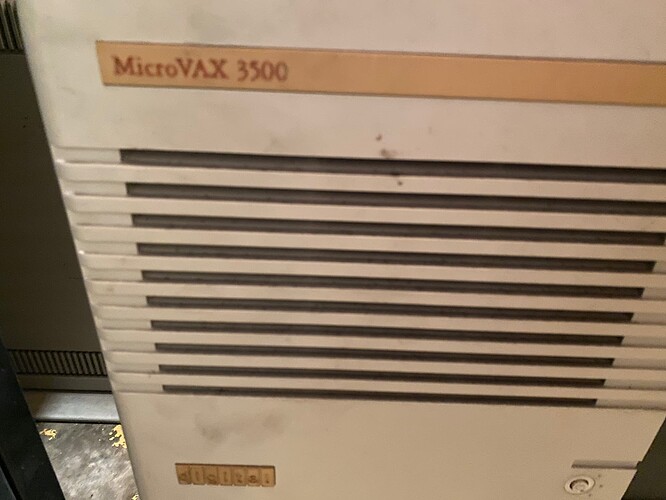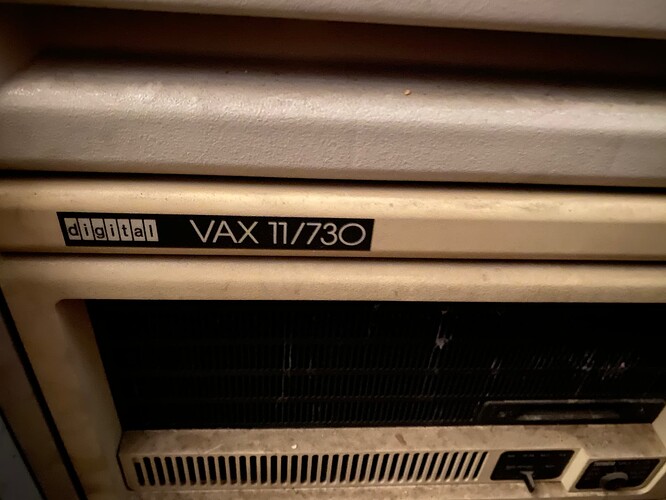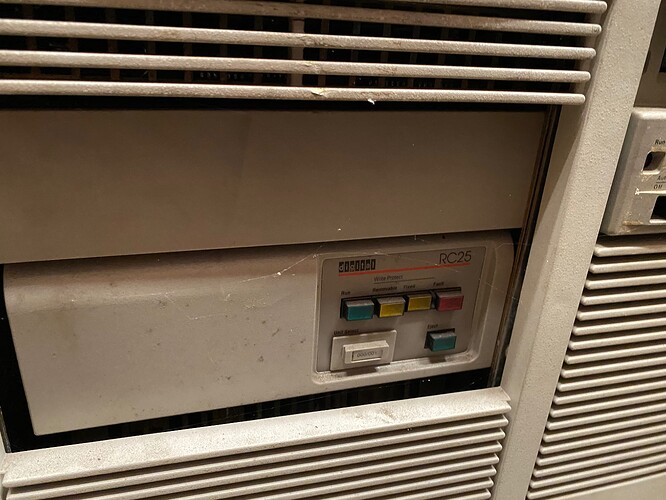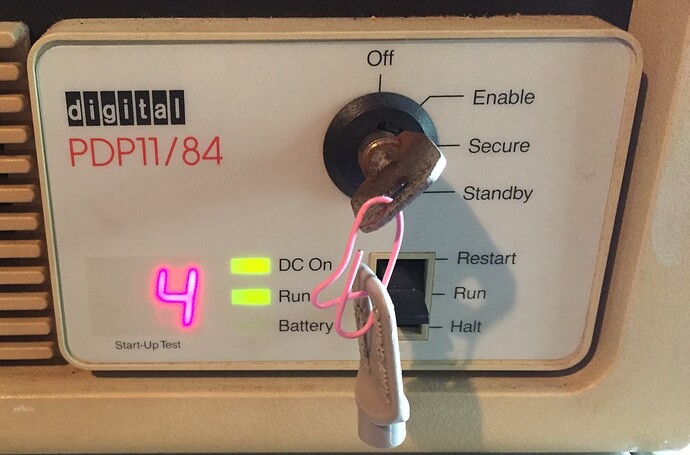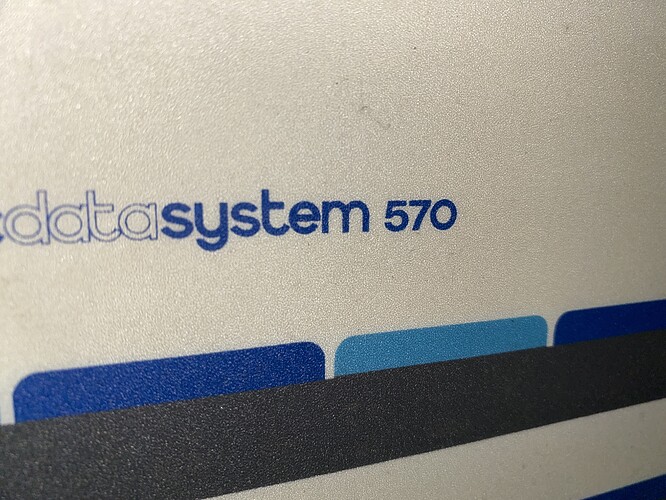I keep a WWW page listing all known PDP-10 system numbers. I am also trying to find all of the PDP-10s that still exist. https://sites.google.com/site/mthompsonorg/Home/pdp-10/pdp-10-serial-numbers
I saw a picture of your PDP-10 KS10 otherwise known as a DECSYSTEM 2020 on Facebook. Could you send me some pictures of the system number label that is on the frame in the back of the system? The system number should be 4xxx. Could you also send me some pictures of the complete machine inside and outside, especially the processor and I/O boards?
I am also a volunteer at the Rhode Island Computer Museum in the USA, and specialize in early DEC equipment.
Hey there,
I have inspected the DEC 2020 system yet can’t find a definitive serial. Maybe these photos will help identify it and maybe you could assist us by telling us what you know about the DEC Data system 2020
Thanks
Adrian
1 Like
The 4577 is the system number of your KS10. MR means that it was manufactured in DEC’s Marlboro Massachusetts factory.
The Temperature Controller is not an original DEC part. It would be interesting to see what fans it controls.
To the left of the fan controller is the breakout panel for the DZ11 octal serial port boards. You should have 16x DB25 connectors on that panel.
The sticker on the top of the Unibus I/O chassis shows that the machine had/has two DZ11 Octal Serial Port boards providing 16x serial ports. The RH11 is a Massbus controller that can be connected to certain models of disk and tape drives. This RH11 is used for magnetic tape drives. It looks like there is a note about a TU45. A TU45 is a Pertec magnetic tape drive with a DEC TM03 Massbus controller added. The final item on the list is a LP20 line printer controller. The LP20 is a 240 line per minute drum printer.
Would it be possible to get images of the front and back of the machine with the doors open and closed, the inside of the Unibus expansion chassis with the lid removed, and the processor chassis with the front cover removed?
1 Like
The PDP-10 is a family of 36 bit mainframes. The KA10 was the first, and was implemented with just transistors. The KI10 was the second, implemented with TTL integrated circuits. The KL10 was the largest and fastest and the processor was implemented with really high performance for the time ECL chips. Yours is the last in the PDP-10 family, and is implemented with TTL and bit-slice chips. It can be used RM03, RP06, and RM80 disk drives, and TU45 or TU77 magnetic tape drives. PDP-10s typically ran the TOPS-10 and TOPS-20 operating systems. The students at MIT developed the ITS operating system that will also run on a PDP-10. ITS is still supported and maintained.
1 Like
Thank you so much for this information! Unfortunately we are having issues finding DEC engineers and service people in Sydney to assist us. We have likely the largest DEC collection in the southern hemisphere with many pieces and frames donated by Max Burnett, original DEC Australia Sales manager and founder of the ACMS.
I will get some photos to you in the next 48 hours, and maybe you can help us put this beast back together!
1 Like
I corresponded with Max many times about DEC equipment. What happened to his huge collection of equipment?
I should be able to tell from the pictures if the machine is complete. If you have a TU45 or TU77 magnetic tape drive, and an RP06, RM03, or RM80 disk drive then you might be able to get it running. Another DEC enthusiast is working on a Massbus disk emulator. When that project is finished it would be simple to connect it to your KS10 and get it running.
1 Like
We have RL02, RK02, TS11, and about 50 other various drives.
We actually hold a chunk of Mac’s collection as he was a founder of the Australian Computer Museum. Another part was sold to the US and another part is being held by another gentlemen that was a colleague of Mac’s - whom I believe is trying to sell it off
1 Like
You could look for TU45 or TU77 magnetic tape drives, or RP06, RM03, or RM80 disk drives in your collection. Those are the only ones that will work on the KS10.
I maintain the only running PDP-9. I would be interested to know if you have any PDP-9 material in your collection. In the remains Max’s collection too.
Mike Ross lives in New Zealand. He collector/restorer who has a KS10 and knows a lot about DEC and IBM systems. I don’t know any DEC experts in Australia.
1 Like
If you have any contacts for Mike Ross, drop them in a Private message to me. I will be onsite and will look more into the KS10 soon.
I never see an envelope when I click on your avatar so I can’t send you a PM. My email is mike@ricomputermuseum.com.
Hey Mike that email is not working.
This should work: Mike Thompson mike@ricomputermuseum.org
The RX02 is a strange double-density 8" floppy diskette drive that can be used on PDP-8 & Unibus or Q-Bus PDP-11 systems. It can be jumpered to be an RX01 which is a normal single-density drive.
The RL02 is one of the most reliable removable drives that DEC made. It can be used with the very rare PDP-8/a controller or with Unibus or Q-Bus PDP-11 systems. It was also used to load microcode on VAX-86xx systems.
We have lots of PDT-11 systems. It is a PDP-11 and runs the RT-11 operating system. All of the GM car dealers in the USA had them.
The VAXstation 3+ is a rare one. I didn’t find much information on it other than this upgrade document: https://manx-docs.org/collections/antonio/dec/MDS-1997-10/cd2/VOL002/0419.PDF
If the TU77 has a TM02 or TM03 formatter in the bottom of the cabinet, then the KS10 should be able to boot diagnostic and OS installation tapes from it.
The VAX-11/780 is the first VAX and has a performance rating of 1 MIPS or 1 VUPS. That is the machine that defined the MIPS. It has a PDP-11/03 in the bottom and loads microcode and diagnostics from the 8" floppy at the bottom right. It needs LOTS of power.
The TU10W is a TE16 drive modified to act like a TU10. If it has a TM02 or TM03 formatter in the bottom of the chassis it might also work with the KS10. Otherwise it works with a PDP-11.
2 Likes
@m_thompson here is some more PDP wonders in the collection. Greg is helping me getting up one of our PDP-11/34? And an RK05 but we may need some help
You have lots of DEC machines! We don’t have a VAX 11/725 in our collection. It is supposed to be the slowest VAX ever made. The 11/24 is a low cost 11/34. The 11/40 is a really nice but complicated machine. It will run UNIX and was also used as the maintenance processor on PDP-10 KL10 systems. The 11/03 is really simple and runs RT-11 nicely. I will look at the specifications for the other VAXen to see what storage devices they support. The might use SDI, DSSI, SCSI, or MFM disks.
Jerry Walker made extremely detailed youtube videos on debugging and repairing an 11/34. You should watch them before you try to fix yours. PDP11-34A Repair Part1 - YouTube
The RK05 disk is not difficult to repair if you have an oscilloscope and some knowledge of digital circuits. There are some issues with the light bulb in the position sensor below the head carriage that can cause problems. There are different RK05 disk packs for PDP-8 and PDP-11 systems.
1 Like
We also have an 11/04, 11/34 if I haven’t mentioned it.
See our latest post about our Micro PDP 11/83 we got running yesterday 
1 Like
I have the same CPU, but in a Unibus chassis so it is an 11/84.
You should inventory the boards in the chassis, and I can help you identify them.
2 Likes
Thought you might like to see this Michael
Nice to see original advertising. Some of the claims are a little bit of a stretch though. I have never seen an automatic SYSGEN.
1 Like
Found another 1970s big boy quad bay unit - do you know much about the DEC DATASYSTEM 570?
Its a PDP-11/70 in a fancy cabinet. The PDP-11/70 was the biggest PDP-11 before the microprocessor versions were introduced. It normally shipped with 1 to 8 RM03 67 MB Massbus disks. It could probably use any of the RM03, RM05, RM80, and RP06 disks that are all Massbus, and with a different disk controller could use just about any disk. It was common to put one or more disks or tape drives in the same cabinet as the PDP-11/70 processor. The processor is a real beast and might be difficult to debug and get running.
The PDP-11/70 at the RICM came with two RM03 disks, and the really dumb front panel without switches and lights.
1 Like


